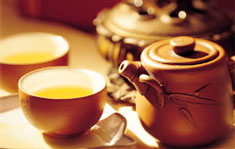In China people drink green tea everyday and every moment of the day. They usually do not use teapots but they use small cups where some tealeaves are placed and then they simply ask for hot water and re-infuse several times during the day. The cups have a special lid that allows drinking loose tea without having to swallow the leaves.

There is also a ceremonial way of preparing the infusion, called
Gong Fu Cha. In China and Taiwan it is used in many teahouses where people go to taste very high quality tea (normally Oolong tea) in a cozy ambient. The teapot and cups used are the famous clay wares from Yi Xing and the accessories needed are: a kettle, a tea boat (a carved wooden or bamboo box with holes on the top used to collect overpouring water), a spare pot, smelling cups and tasting cup.
The Gong Fu Cha ceremony varies according to the specific area of the Country, but in general the basic steps are as follows:
- The teapot and the cups are placed on the "boat" (a bamboo draining tray)
- Hot water is poured into the teapot and then is emptied in the spare pot
- Enough leaves are put in the teapot to fill it halfway and then they are rinsed with hot water that is immediately transferred into the spare pot
- The content of the spare pot is then poured in the boat
- The teapot is filled to the top (actually slightly overfilled to eliminate any residual impurity), and the leaves are left to infuse for around one minute, after which the liquor is transferred to the spare pot
- The smelling cups are filled from the teapot and then the content is transferred, this time by the guest himself, into the tasting cup
The reason why the liqour is served into the smelling cup first, is to give the guest a chance to enjoy the perfume of the residual liquor after it has been poured into the tasting cup. This step is considered to be the heart of the ceremony by many tea tasters, as it allows one to recognise very subtle notes that are not easily picked up by simply drinking the liquor.The tasting cups are used to savor slowly the liquor with little sips. The infusion resulting is quite strong.